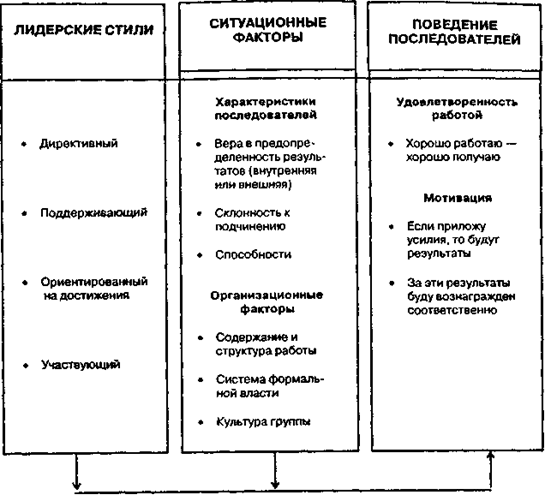home
 Management Management
 Management - Vikhanskiy OS Management - Vikhanskiy OS
|
Management - Vikhanskiy OS
3.4. The model of leadership "the way - the goal" of House and Mitchell
The model of situational leadership in question was developed in the 1970s. [8]. In its basis, it is based on the motivational theory of expectation (see Chapter 2). The premise is that workers are satisfied and productive when there is a strong connection between their efforts and performance, and between the result of work and reward. Hence the model got its name. There is a direct relationship between the level of leadership effectiveness and the level of motivational power of expectations that followers have. Ideal is the option, when the reward is fully consistent with the result. The model states that an effective leader is one who helps the subordinates to follow the path leading to the desired goal. In this case, various options for the leader's behavior are suggested, depending on the situation (Figure 11.15).
Directive leadership is a high level of structuring work, explaining to subordinates what and how to do, and also what and when is expected of them.
Supportive leadership is a great deal of attention to the needs of workers and their well-being, the development of a friendly working climate and the treatment of subordinates as equals.
Leadership, focused on achievement , - the establishment of tense, but attractive goals, huge attention to quality in everything, confidence in the abilities and abilities of subordinates to achieve a high level of performance.
Participating leadership is a council with subordinates and attention to their suggestions and comments in the course of decision making, involving subordinates to participate in management.
Unlike Fidler's concept, this model assumes that leaders can change their behavior and manifest one or all of these styles. According to the model, an effective combination of leadership styles depends on the simulation.
For the analysis of the situation, the model offers two types of situational factors: characteristics of followers and factors of the organizational environment. The following parameters are used to describe the characteristics of followers and the choice of this or that leadership style .

Fig. 11.15. Model of situational leadership "path-goal" of House and Mitchell
Belief in the predetermination of what is happening from the actions of the individual. There are two types of behavior of subordinates:
• People are internally confident that the reward they received was determined by their efforts;
• People believe that the amount of remuneration received was controlled by external forces.
The former prefer the participating style of leadership, and the latter are more satisfied with the directive style.
Propensity to submission. This parameter is associated with the individual's desire to be guided, internally to accept the influence of others. Those who are inherent in this prefer a more directive style. Others seek to participate more actively in management.
Abilities. The ability and experience of followers determine how well they can work with an achievement-oriented leader, or with a leader that attracts them to participate in management.
The model identifies the following factors of the organizational environment that affect the choice of the appropriate leadership style:
• content and structure of work;
• a formal system of power in the organization;
• group dynamics and norms.
These three factors can influence the effectiveness of the chosen leadership style in different directions. So, a highly structured task does not require the leader to be extremely directive in management. At the same time, in an organization with a rigid hierarchy of power, a decision-making leader is more effective than a leader seeking to attract subordinates to take part in management. The care of the leader about the needs of the subordinates will look somewhat artificially in the group with a high degree of cohesion. In general, as shown in Table. 11.6, within the framework of this or that leadership style, there is an interaction between the characteristics of followers and organizational factors that influence the perception of motivation by followers. In turn, the perception of the followers of the situation and the level of motivation of followers determine their satisfaction with the work, the level of performance of work and the recognition of the leader.
Table 11.6.
Examples of the application of the situational leadership model "path-goal"
Situation |
Leader Style |
Impact on the subordinate |
Result |
Ambitious task |
Directive style |
Provides direction and clarity in actions |
Attached more effort |
|
Insufficient remuneration |
Directive style |
Explains the path to reward or increases the reward |
Attached more effort |
Tiring and uninteresting work |
Supporting style |
Increases interest in work |
Attached more effort |
|
Uncertainty in the forces |
Supporting style |
Facilitates understanding of the role and enhances the expectation of reward |
Attached more effort |
|
Lack of opportunities Excel |
Style oriented To achieve |
Provides tense and challenging goals |
Attached more effort |
The task or goal is not defined |
Participating style |
The goals and parameters of the work are clarified |
Attached more effort |
Practical application of the model by managers directs them to use different styles depending on the situation. At the same time, it should be remembered that it is not the results of the subordinate's work that should influence the choice of the manager of a particular style, but, on the contrary, the chosen style should help to improve the level of performance of the work.


Comments
When commenting on, remember that the content and tone of your message can hurt the feelings of real people, show respect and tolerance to your interlocutors even if you do not share their opinion, your behavior in the conditions of freedom of expression and anonymity provided by the Internet, changes Not only virtual, but also the real world. All comments are hidden from the index, spam is controlled.